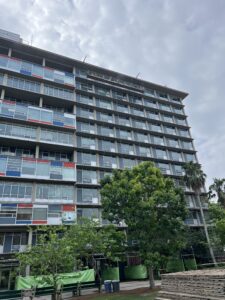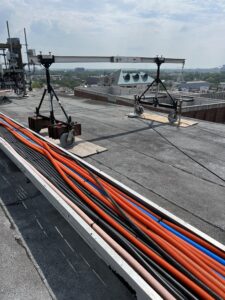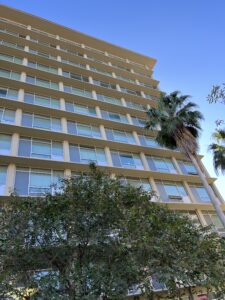Monroe Hall Restoration: Making a Stronger Home for Tulane First-years
Monroe Hall is a 12-story residence hall for first-year students at Tulane University, offering panoramic views of campus and Uptown New Orleans. Built in 1963, it’s one of the campus’ few remaining Mid-Century structures. Baker Construction was contracted for an extensive exterior restoration project to preserve the building’s concrete overhangs.
The original scope called for approximately 40 form-and-pour repairs. After the overhang repairs, the restoration team planned to grind a one-foot area around the front ledge of each overhang to prepare for the installation of bi-directional glass fiber fabric. The team intended to use manlifts, with crews working one shift per day during the University’s summer breaks.
Because restoration work was restricted to student breaks, the project was scheduled in three phases from May to August over a three-year period: 2023 to 2025.
Trouble in the Big Easy
Several issues surfaced shortly after work began. Manlifts proved difficult to maneuver and provided only limited work areas, slowing progress. The repairs also revealed weak concrete that was hidden beneath the existing coatings. As the team chased poor concrete along the overhang face, the repair areas expanded significantly.
In addition, the existing membrane would not bond to the final paint layer. This meant the entire ledge had to be ground down, rather than a one-foot section.
Excessive heat added another layer of complexity. The daytime surface temperature on the overhangs regularly exceeded 115°F, which was too hot to install the bi-directional glass fiber fabric with an epoxy adhesive.
Creative Solutions to Shifting Conditions
With approval from Tulane’s engineers, Baker replaced manlifts with swing stages to increase efficiency and workspace. The swing stages provided 40 feet of workspace and accommodated more workers and materials.
The restoration team also introduced new repair methods. For smaller, non-structural areas, the team proposed removing loose concrete, drilling in mechanical anchors, and hand-packing material back in. Then, the team could form and pour areas as needed. Tulane’s engineers approved the approach, which was key to efficiently restoring the overhangs’ original shape and preparing them for the bi-directional glass fiber fabric installation.
The restoration team also added a night shift, enabling the project to be completed with no compromise to quality. Coating reports were conducted four times throughout the day to confirm the weather was suitable for installation.
Baker completed one-third of the planned work during the first summer — and gained valuable insight into how to tackle the next phase.
The Benefits of an Experienced, Field-Tested Team
During the 2023-2024 school year, Baker planned and refined processes, incorporating lessons learned into detailed work plans.
When work started in 2024, Baker set up swing stages from the start to create larger work zones and reduce setup times. Crews were given specific tasks and clear, structured work assignments by zone every day.
The team implemented a new procedure to hand-pack repair mortar and fill imperfections to smooth the overhang faces for the bi-directional glass fiber fabric. The team also leveraged resources from across Baker, including bringing in additional talent from LRT Restoration Technologies in Ohio.
By the end of the summer of 2024, Baker completed the side of the building that was started the summer before, plus two end caps — setting the team up for planned completion in 2025.
Clear Communication and Precision Planning Pay Off
The Monroe Hall Restoration evolved significantly since it started — but Tulane hasn’t sacrificed schedule or quality at any stage. Baker’s meticulous planning and management kept the crew productive, even in challenging conditions. Clear communication and collaboration with Tulane’s engineers allowed the team to adapt quickly and deliver quality concrete solutions. And above all, the team’s low-disruption approach kept any interruptions to Tulane’s summer operations to a minimum, ensuring the residence hall was ready to welcome students for the fall semester.
Baker’s innovative approach to the restoration earned a 2024 Excellence Award from the Pelican Chapter of Associated Builders and Contractors. This project showcases Baker’s ability to overcome obstacles, innovate, and deliver high-quality solutions for complex and evolving projects — and will strengthen Monroe Hall for future generations of Tulane students.



